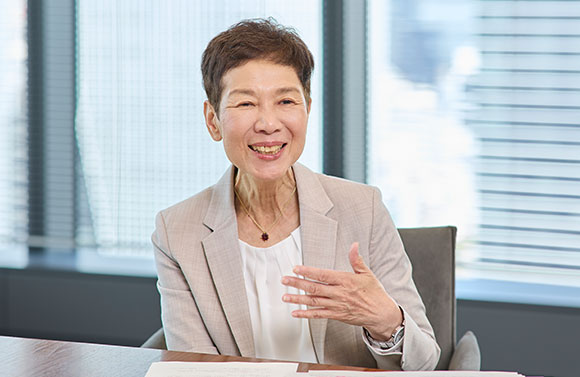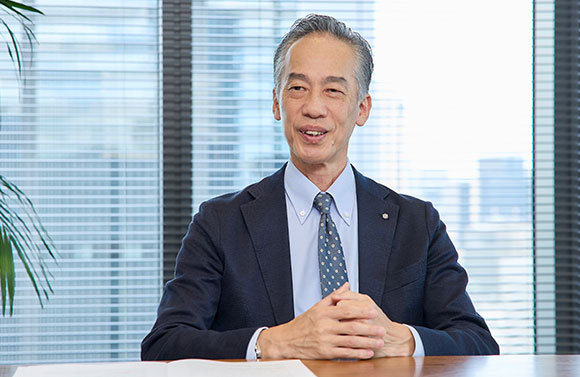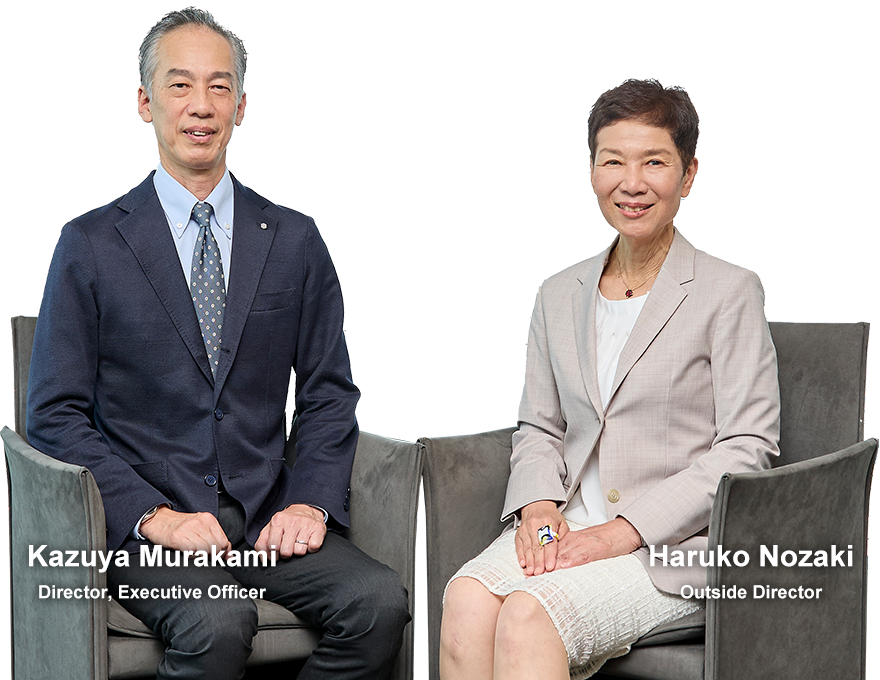Discussion between an Outside Director and the Director in charge of the Human Resources Department (2025)
Please share some information on current human capital initiatives, including your evaluation and response to them.
Murakami:Our human resources philosophy is that “employees are precious assets bestowed on us by society.” Our commitment to investing resources in employee development is consistent and has not changed. In the past few years, we have focused on developing a human resources system that is linked to our management strategies, while at the same time making a strong effort to visualize and communicate our human capital initiatives both internally and externally. Furthermore, in order to verify the effectiveness of deployment measures, we are working on the introduction of productivity indicators to check whether they are linked to management indicators.
Nozaki:I feel that just as the Group has created innovation through its products, we are also pioneering in our human resources strategy. I also appreciate, as a sign of management’s determination, the clear statement in the Medium-term Management Plan that the Group will invest 12 billion yen over three years in human capital. “Personal growth” has become a keyword for those who are current employees, and it is extremely important for the future of human resources to visualize and match both what abilities they have and what abilities the Group is seeking. As a company with diverse businesses, I think it is wonderful that the system is designed in such a way that the characteristics of each business can be utilized by carefully and precisely visualizing how they relate and combine with each divisional company.
Murakami:I would like to continue to formulate and implement human resources strategies from a medium- to long-term perspective, with the divisional companies and Corporate Headquarters working in tandem.
Nozaki:I believe that an area where the Corporate Headquarters can exert its strength is to be involved in each divisional company’s succession plan and to promote the right people in the right places across the Group. In any case, I feel that the attitude of being cautious yet boldly seeking a way that is appropriate for the Group is a true symbol of our corporate culture.
How would you assess the Employee Challenge Action Rate, with respect to engagement?
Murakami:The Employee Challenge Action Rate is now a key human capital KPI for our Group, and the president himself continues to communicate this in order to encourage each and every employee to take on challenges. Although the most recent result of 56% is a significant increase, we are not yet satisfied with this figure. I strongly feel that further efforts and measures are needed in terms of whether we are appropriately evaluating how employees take on challenges and whether employees are gaining a sense of growth.
Nozaki:Both the Employee Challenge Action Rate and engagement scores tend to be higher overseas. It is important to look at changes in scores rather than looking at them as absolute values, as Japan tends to have lower scores, perhaps out of modesty or a desire to perform better. Furthermore, in order to compete in the intensifying global marketplace, an objective for the future will be to cultivate employees with a mentality that is at times able to say, “I am taking on challenges, and therefore, I want to make such-and-such request.”
Murakami:Additionally, now is an important time when the numbers are in an upward trend. For example, how can we take measures to deal with a situation such as an employee asking, “I went after some big challenges, but am I being fully evaluated?” I think that the real test for us is from this point forward.
Nozaki:One of the proposed plans to deepen understanding of employee challenge actions is “Talk with Top Management,” where employees can directly discuss working styles and innovation with the Company’s officers. I have participated in this several times. What I have found is that employees speak up without being overly deferent, and the president and other officers respond with candor. The attitude of the top management is to welcome failure and encourage a challenging spirit, which is impressive and seems to have led to a greater sense of trust and engagement among employees.
What is the status of the Diversity Promotion Committee’s efforts and what is the significance of its direct connection to the Board of Directors?
Nozaki:I am the chairperson of the Diversity Promotion Committee. All of the outside directors are members of the committee and we have lively discussions and recommendations each time we meet. For example, some suggested that the target ratio of female hirees be raised even further, while others suggested that women be made more welcome in mid-career recruitment, or that the positions of Group company officers be further utilized for the development of executive candidates. Many suggestions have actually been adopted as measures, and I feel that the committee is functioning effectively. It is probably rare in Japan for such a committee to be positioned as an advisory body to the Board of Directors.
Murakami:We have adopted an advisory committee format because we believe that the executive team should willfully and responsibly carry out their duties while taking into account the experience and knowledge of the outside directors. In fact, Director Nozaki and others have asked us many questions and made many suggestions concerning human resources and Company organizations.
Nozaki:I can say this because I am not on the executive team, but I feel that there should be more speed in the implementation of measures.
Murakami:Duly noted! Even though we in the HR Department think that we are reforming at a good pace, we have received many suggestions to do even more, which has been stimulating in a good way.
Nozaki:We are discussing not only surface-level efforts such as raising the percentage of women, but also DEIB (diversity, equity, inclusion, and belonging) as an integrated whole. I believe that the ultimate goal of diversity is belonging, which means the same thing as engagement, or in other words, to be proud to be a member of our Group and to be able to use our differences as our strength while being one’s own person, resulting in the growth of both the individual and the Company.
What specific initiatives do you have in mind for realizing the active participation of diverse human resources in the future?
Murakami:Currently, the percentage of female hirees is approximately 30%, the percentage of newly appointed managers is approximately 10%, and the percentage of women in all management positions has been pushed up to 5%, but we still need to increase the percentages to meet our numerical targets. The essential objective is not the numerical target itself, but rather to create a workplace environment conducive to diverse work styles — an environment that allows people to work in their own way — which in turn will lead to the growth of the Company. For example, we are promoting a mentoring system for female managers as a new trial project. With predominantly male supervisors, female managers have different careers that they have charted, and they have a number of concerns that have not been shared in the normal line of work in the past. Through these efforts, we have realized certain effects, such as identifying areas of focus and areas for improvement to close the gap with the actual feelings of the employees involved. I also believe that improving the work environment will provide more opportunities for senior employees who are caring for their parents or have other life circumstances. I believe there are still many points that can be improved.
Nozaki:I believe so, too. When we talk about the active participation of diverse human resources, the focus tends to be on female managers, but essentially, we need to go beyond external diversity, such as gender, to realize diversity in a broader sense, including internal diversity. Even if we start out by increasing the percentage of women hired and the percentage of female managers, I believe that a wider range of diversity, regardless of age, nationality, job category, or organization, will lead to better performance and innovation.
In the midst of a worker shortage, how would you assess our human resource portfolio and which demographics do you think we should focus on?
Nozaki:Innovation requires not only those who create 1 from 0, but also those who build 10 from 1, and those who expand 10 to 100 and then to 1,000. Furthermore, since we are a manufacturing company, there are more detailed processes and skills involved. For the next Medium-term Management Plan, I expect to see a human resource portfolio that fits the strategic portfolio targeted in the Plan by visualizing the excesses and deficiencies in man-hours and skills that will be needed in the future, and by providing opportunities to expand missions and possibilities in all directions. At the same time, it is clear that the labor shortage will become even more serious in the future, so how much will we be able to utilize the strengths of non-Japanese personnel, senior personnel, and people with disabilities? I hope that the Company can be a pioneer in this area by drawing on our wisdom.
Murakami:In terms of recruitment, Director Nozaki has pointed out to me how much we depend on hiring new graduates. Currently, the Group as a whole hires more than 1,000 people annually, of which more than half are new graduates, but the reality is that the Group struggles every year to secure the target number of employees. Recruitment teams invest a great deal of energy in recruitment activities, from forming a pool of candidates, to selection and follow-up after job offers. I believe that the time has come for us to shift to a more flexible and responsive recruitment model to meet the changing needs of the market and the type of human resources we seek.
Nozaki:From the standpoint of academia, I would like the Group to appeal to candidates with the fact that they can do such interesting and socially useful work, and to actively recruit people with doctoral degrees and develop internships.
Please tell us about initiatives and your evaluation of DX, ESG, and global human resource acquisition and development.

Murakami:Currently, the Group’s overseas sales account for approximately 30% of our total sales, and, since we expect further expansion in the future, we urgently need to develop global human resources. In operating a global organization, the majority of management has been carried out by expatriates from Japan, but in the next Medium-term Management Plan, the intent is to strongly emphasize the importance of having the right person in the right place from among the entire Group’s human resources. We would like to promote the development of successors in each of our overseas subsidiaries to a greater extent than before, and in the future, we would like to entrust the management of our overseas subsidiaries to a large number of local personnel. Regarding ESG human resources, we will focus on developing management personnel who can correctly understand and explain the significance and social impact of our business, rather than being “ESG experts.”
Nozaki:Examples of multiple career paths to the top are essential for overseas subsidiaries. Which applies to head office directors as well. It would be nice if ESG human resources could be motivated to take pride in their roles. Rather than internal recognition, I believe that recognition of one’s expertise, such as being recognized as a leading expert in an industry or academic society, is a motivating factor, so I feel it is important to successfully convey such appeal.
Murakami:Now, with regard to DX, speed is required. We are moving to enhance the treatment and benefits offered to professionals in order to attract outside human resources with immediate skills. In reality, however, it is difficult to hire such professional personnel, and we believe that internal training of DX human resources is the key. We are actively promoting reskilling of internal personnel.
Nozaki:I appreciate that we can see the consistency between the management strategies and human resources strategies, and that the system of recruitment, appointment, and training is being developed in an integrated manner.
How do you view the decision-making process and effectiveness of the Board of Directors?
Nozaki: Information on agenda items is carefully shared in detail, including background information, creating an environment in which I can convey messages with confidence as an outside director. The process provides an opportunity to see our Company from a three-dimensional perspective by inspecting production plants and research laboratories to learn about the enthusiasm of our employees and their awareness of the issues they face. The quality of discussions has also improved, as the outside directors have built a relationship that allows us to frankly exchange opinions and ask each other questions, rather than just engage in formal exchanges. Meanwhile, there are many occasions when questions from the outside directors are the only questions being asked, and I would like to see more time spent on discussions between divisional companies at Board meetings. I think it is great to be serious and free from waste, but it might be nice to have a little more latitude, such as recognizing and praising mutual efforts.
How do you evaluate the diversity of the Board of Directors and how do you think it should be enhanced in the future?
Nozaki:There is diversity in the careers of male and female officers, the Audit & Supervisory Board members speak from a professional perspective, and diversity is well represented. Common sense for the Company is not necessarily the common sense of society. Common sense changes with the times, and sensitivity to different experiences, standpoints, and changing eras is important. If I had a wish, I would be glad to see more younger generations on the Board, as the average age of today’s outside directors is getting older. As I look at the next 10 years over which to play this important role, I believe that the views of the younger generation will become more important.
Director Murakami, as the head of the Human Resources Department, please tell us about the challenges you see.

Murakami:A challenge for me is to visualize employees’ challenges and establish a satisfactory evaluation system. There is no point in doing things just because “the president says so” or because “the boss says so.” I believe that my own challenge is to create a system in which supervisors and subordinates can set and execute agreeable challenges that are in line with reality, evaluate them appropriately, and establish an atmosphere and corporate culture that encourage people to keep challenging themselves.
As an outside director, what would you like investors to expect from the Group?
Nozaki: The Group has outstanding technological capabilities and a strong supply chain that connects diverse markets. Having reliable “earning power” is truly the strength of a company with multiple businesses. In addition, the management team is positive and has a discerning eye for the essentials, while the employees take on the challenge of solving social issues with pride and a sense of responsibility. I believe that the strength of these human resources is the source of our corporate value. In addition, the corporate culture symbolized by the 3S Principles (service, speed, and superiority), as well as the ability to flexibly transform business portfolios in accordance with the times, are also key to competitiveness in an uncertain era. I hope that those following the Group will focus on the power of human capital and culture, which are not easily expressed in financial indicators, and will look forward to the long-term growth of SEKISUI CHEMICAL Group.

